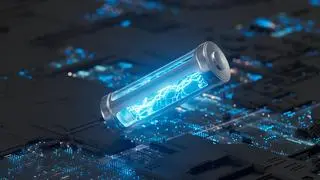In electronics, electrons run errands for us — like carrying data from one point to another. But in the recent years, scientists have been turning to photons — particles of light — to do similar jobs.
We all know Integrated Circuits or ICs; soon we will be similarly familiar with ‘photonic integrated circuits’ or PICs. Welcome to the world of photonics.
For decades, we have been using optic fibres for communication. When you say ‘hello’ into the phone, the sounds get converted into electrical signals which are again converted into light (photonic) signals by devices called transceivers. The light travels through the fibre and gets converted back to sound for the person at the other end to hear your ‘hello’.
Now imagine doing this inside a chip — for applications in high-speed communications and areas beyond communications, such as data processing and sensing. After all, light travels much faster than electrical signals, so you can process larger amounts of data quicker and with significantly less power consumption. “Photonics in semiconductors will bring the characteristics of light in terms of speed, bandwidth and low-loss to create things that we have not even thought through,” P Raja Manickam, a semiconductor industry veteran, who has started a fabless chip company, iVP Semiconductor Pvt Ltd, told quantum.
Scientists, like Dr Bijoy Krishna Das, Chief Investigator at the Silicon Photonics Centre of Excellence, Center for Programmable Photonic Integrated Circuits and Systems (CoE-CPPICS), IIT Madras, say that there are various merits in weaving photons into electronic circuits. Das told quantum that in conventional electronics, components (such as wave guides) are inherently limited by their capacity to handle high power — an area where photonics can step in. PICs can complement the electronic industry, Das said.
Also read
Science to engineering
While the science of photonics is quite clear, the problem is in engineering.
A PIC is an assembly of ‘photonic elements’. These include lasers (light source), waveguides (channels that guide light within the chip), photodetectors (converts light into electrical signals), multiplexers and de-multiplexers (combine or separate multiple wavelengths of light) and amplifiers (boost the power of light signals to overcome transmission losses).
While the world of photonics is all set to come up with engineering solutions to give science its playfield, many changes remain.
Weaving photons into electronics to make PICs is not easy. Silicon, the dominant semiconducting material, does not naturally emit laser light from electrical signals. So, coupling the photonic elements with silicon is fraught with challenges. One such is ‘Poor coupling efficiency’ — where light from the source is not properly guided into the photonic element, resulting in an underwhelming performance.
Research into engineering these products is happening globally, and by many accounts, India is not lagging. For example, theCPPICS-CoE at IIT Madras is developing “novel photonic devices for various applications such as computations and sensing”. Its products include various photonic elements and processors whose uses can go all the way up to quantum computing.
Silicon meets light
Researchers at IIT Bombay and the Tata Institute of Fundamental Research (TIFR) have developed a “novel method of using silicon nitride to enhance the efficiency of photonic devices”. To tackle the issue of poor coupling efficiency, they turned to the same material for the emitters as well as for photonic elements, in a process called‘monolithic integration’.
Silicon Nitride (SiN) is a good light emitter (single photon emitter) at room temperature. It can also be easily made with the current semiconductor fabrication techniques (or, the CMOS technology — complementary metal-oxide semiconductor).
The research resulted in the development of a SiN structure called ‘microring resonator’ for better coupling. The structure features a microcavity, where light revolves around the microring resonator, effectively trapping it to stimulate its emission. This microcavity is engineered to host the so-called “whispering gallery modes” (WGMs). A whispering gallery mode is a phenomenon where sound or light waves travel around the inside of a curved surface, like the walls of a circular room or a sphere, without losing strength — whispers (light signals) can be heard or detected from far away on the opposite side of the curve. The researchers also created a ‘notch’ in the microring, which functions as a point where light enters and leaves the ring.
Calling this a “breakthrough”, IIT Bombay in an article in its website says that its researchers have “demonstrated an efficient coupling of these light emitters.” This uncovers “new and effective means of extracting the trapped light, which had previously encountered significant challenges,” it says.
The breakthrough could mean that we may eventually be able to manufacture on-chip emitting devices for many photonic and quantum technologies. The research has shined a light on the potential of silicon nitride to serve as a platform that “can efficiently manipulate light on a very small scale.”
Kishor Kumar Mandal, who was involved with the research, notes that the development “contributes significantly, by enabling efficient light-matter interaction, controlled quantum emission, enhanced photonic devices, simplified integration, and the potential for quantum computing in quantum photonics.”
These advancements pave the way for groundbreaking applications in secure communication, ultra-fast computing, and other transformative technologies that will shape the future of science and technology, he says, in the article.









Comments
Comments have to be in English, and in full sentences. They cannot be abusive or personal. Please abide by our community guidelines for posting your comments.
We have migrated to a new commenting platform. If you are already a registered user of TheHindu Businessline and logged in, you may continue to engage with our articles. If you do not have an account please register and login to post comments. Users can access their older comments by logging into their accounts on Vuukle.